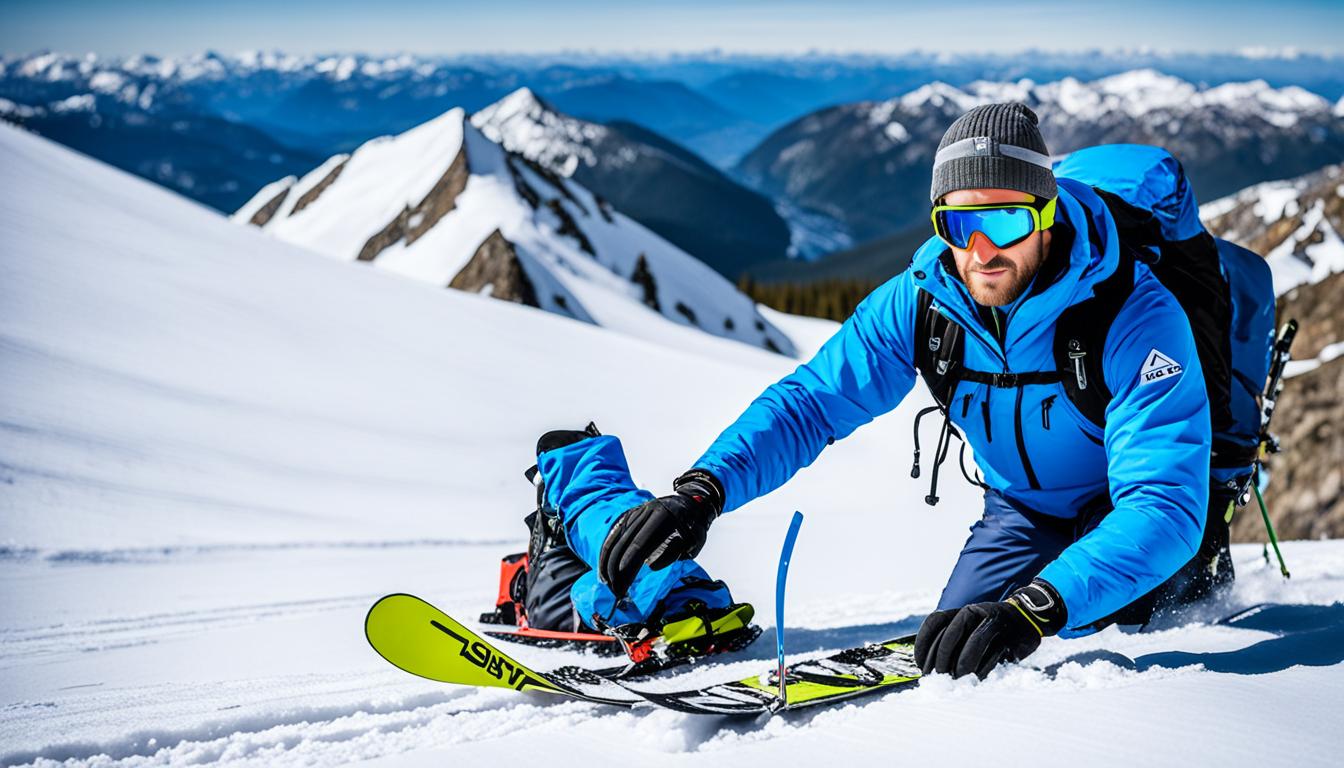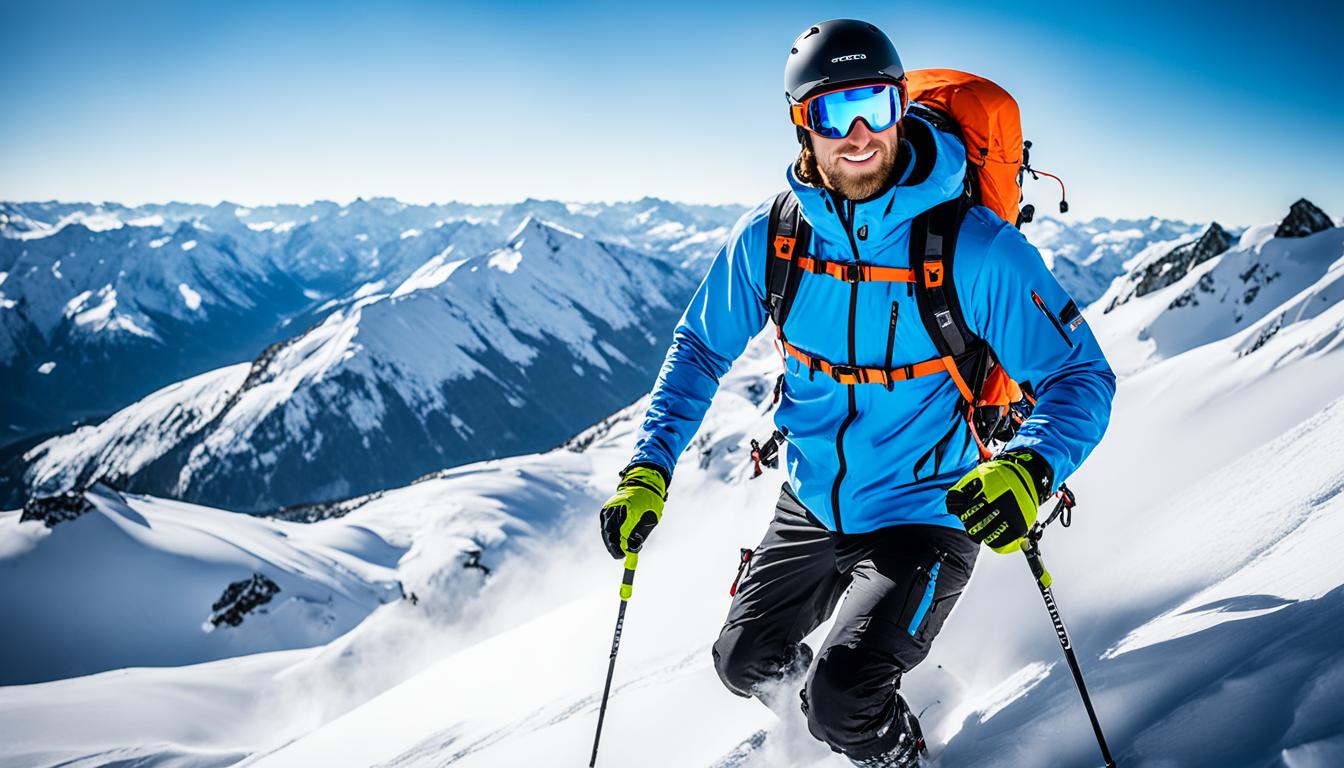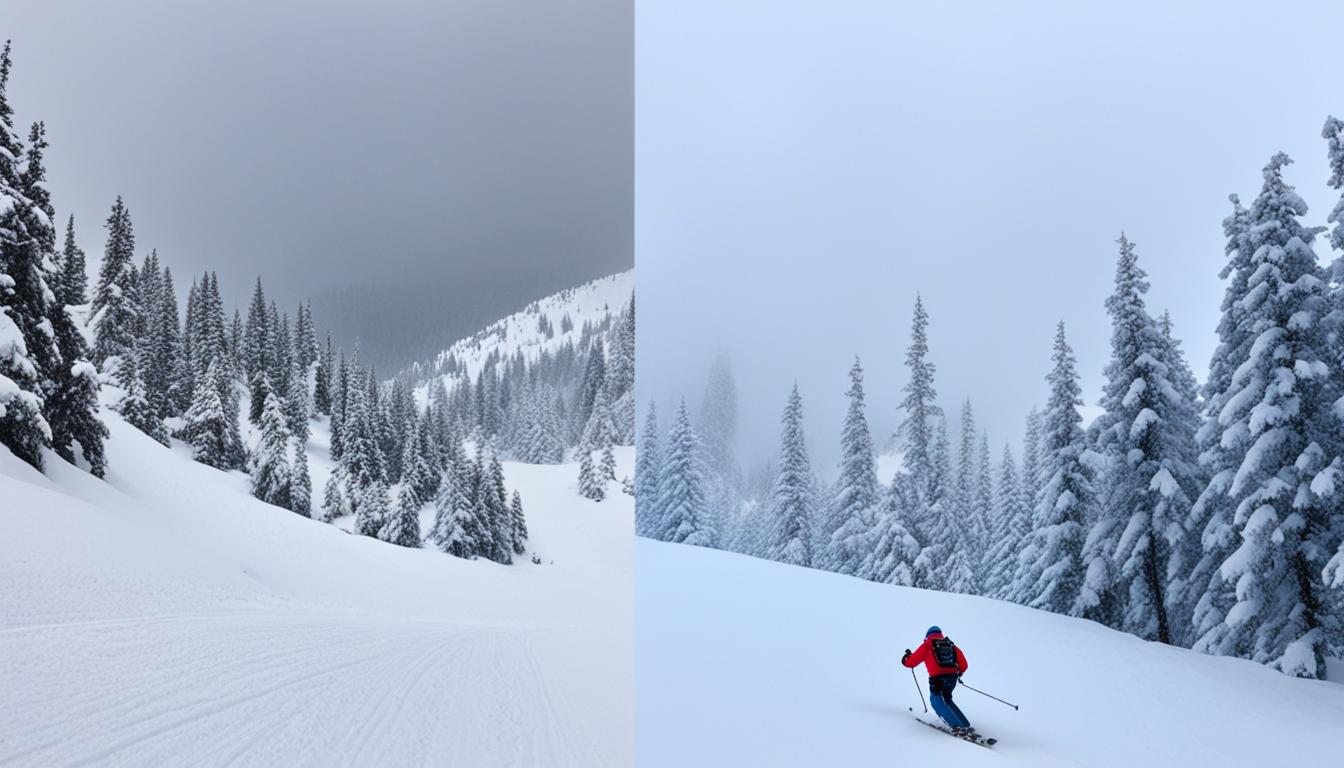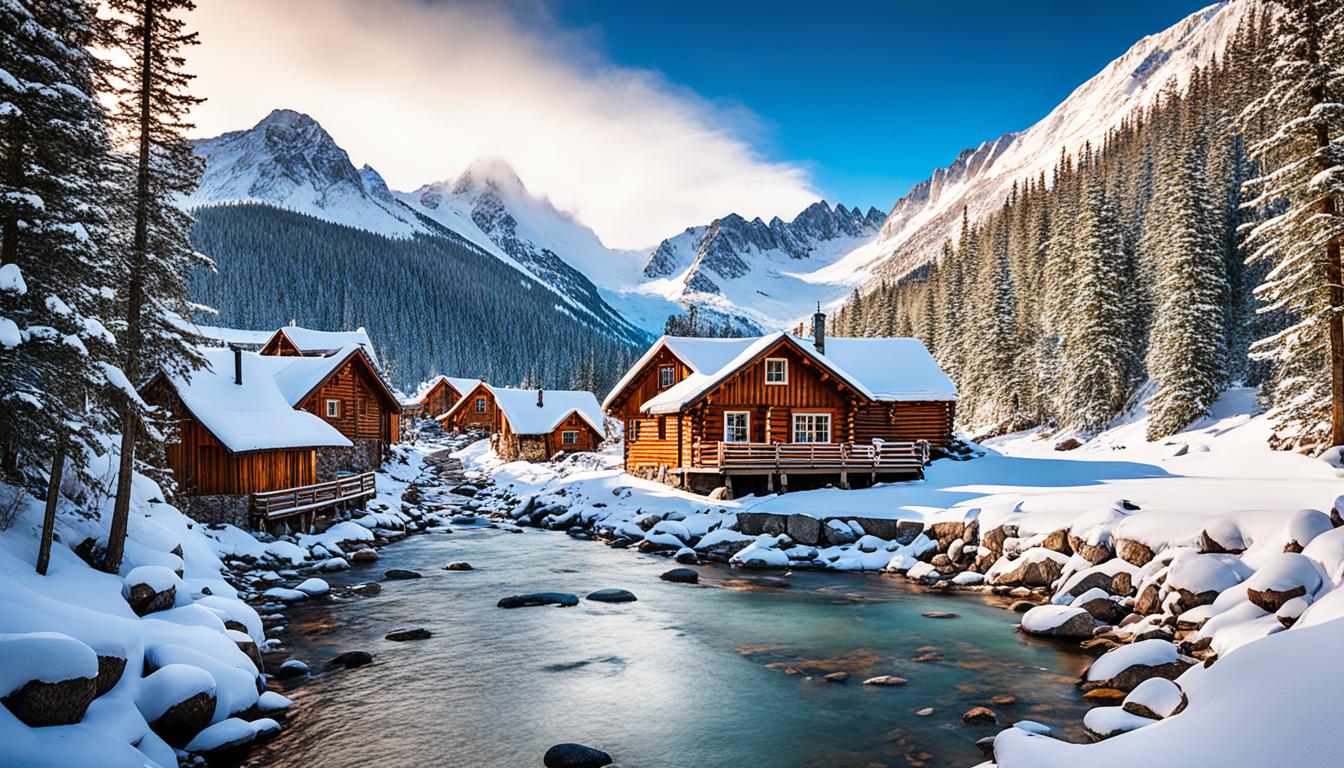Getting ready for backcountry skiing isn’t just about picking the best gear and checking the weather. It’s also about getting yourself in great shape. This helps give you the confidence to tackle the slopes and reduces the chance of getting hurt. Adding the right exercises and training to your daily routine boosts your physical fitness. This makes your backcountry skiing adventure more fun and memorable.
Key Takeaways:
- Fitness is essential for backcountry skiing preparation.
- Physical conditioning for backcountry skiing helps improve performance and reduces the risk of injuries.
- Incorporate cardio, strength training, and core exercises into your backcountry skiing fitness program.
- Gradually increase the intensity and duration of your workouts to match the demands of backcountry skiing.
- Proper nutrition, hydration, and practicing skiing techniques are also important for backcountry skiing fitness.
The Importance of Cardiovascular Fitness for Backcountry Skiing
Good cardio fitness is crucial for backcountry skiing. It helps you have staying power, stamina, and do well on the slopes. It lets you go uphill easily and stay strong all through your trips.
Doing activities that make your heart beat faster is key. This could be running, biking, or using a Stairmaster. These exercises boost your heart and lung health. They help make sure your muscles get plenty of oxygen when you’re working hard.
Working on your cardio is important for long days on the mountain. It’s needed whether you’re reaching new spots for powder or skiing tricky paths. Strong cardio means you’ll do better and have more fun.
The Benefits of Cardiovascular Fitness for Backcountry Skiing
“Cardio fitness is everything for backcountry skiing. It lets me take on long climbs and descents without tiring. My heart and lungs can keep up all day.” – Emily, Experienced Backcountry Skier
Getting your cardio in shape helps a lot when skiing:
- It means you can handle longer, tougher paths
- You recover faster between hard ski days
- Makes it easier to deal with high places and bad weather
- You can keep a steady body temperature when working hard
Backcountry skiing is tough, especially at high spots and over long times. Being fit helps you enjoy it more and meet the challenges head-on.
As you work on your cardio, make sure to go at your own pace. Slowly making workouts harder helps avoid getting hurt. It also gets your body ready for backcountry skiing.
No matter if you’re new or a pro, cardio fitness is vital for enjoying backcountry skiing. It boosts your skill and fun in the sport.
| Cardio Exercise | Duration | Frequency |
|---|---|---|
| Running | 30-60 minutes | 3-4 times per week |
| Cycling | 60 minutes | 2-3 times per week |
| Stairmaster | 30-45 minutes | 3-4 times per week |
| Interval Training | 20-30 minutes | 2-3 times per week |
Building Strength for Backcountry Skiing
Building strength is key for backcountry skiing. It helps you stay in control and stable on the slopes. Include specific exercises in your fitness plan to do better and lower injury risks.
Focus on exercises that target the muscles used in skiing, such as the quads, glutes, and hamstrings. Exercises like lunges, squats, and deadlifts are great. They work these muscles and build the power you need in backcountry skiing.
“Strength training is a crucial component of any backcountry skiing fitness program. By targeting the key muscles used in skiing, you can enhance your stability and control on the slopes.” – Sarah Johnson, Certified Ski Fitness Trainer
Adding strength exercises to your fitness plan boosts your performance. Strengthen your lower body to keep good form and balance on tough ground.
For a well-rounded strength training routine, consider the following exercises:
- Lunges: This exercise targets your quads, glutes, and hamstrings. Take a step forward, ensuring your knee is directly above your ankle. Lower your back knee down towards the ground, then push through your front heel to return to the starting position. Repeat on each leg.
- Squats: Squats work your entire lower body, including your quads, glutes, and hamstrings. Stand with your feet shoulder-width apart, then lower your body down as if sitting back into a chair. Keep your weight in your heels and your knees in line with your toes. Push through your heels to return to a standing position.
- Deadlifts: This exercise targets your hamstrings, glutes, and lower back. Hold a barbell or dumbbells in front of your thighs, keeping your feet hip-width apart. Hinge at your hips, lowering the weights towards the ground while keeping your back straight. Push through your heels to return to a standing position.
Start with lighter weights and slowly add more. Always keep your form right to prevent injuries.

Include strength training in your plan two to three times each week. Add cardio workouts and core exercises. This makes for a complete training routine.
Benefits of Strength Training for Backcountry Skiing
Strength training has many pluses for backcountry skiers:
| Benefits of Strength Training for Backcountry Skiing |
|---|
| Improved control and stability on the slopes |
| Enhanced power and endurance |
| Reduced risk of injuries |
| Increased muscle strength and tone |
| Improved balance and coordination |
By doing the right strength exercises, you can boost your skiing. This lets you face the slopes with more confidence.
Core Stability and Balance for Backcountry Skiing
Core stability and balance matter a lot in backcountry skiing. They help you keep the right body position and steady control. This is crucial when you face tough terrain. Strengthening your core and practicing balance exercises will improve your skiing skills.
Building Core Strength
Work your abs, hips, and glutes to build a strong core for skiing. These areas are critical for stability. Try exercises including:
- Planks: Start in a push-up pose, with your forearms down and elbows beneath your shoulders. Keep this for 30-60 seconds, using your core.
- Russian Twists: Sit down with bent knees and flat feet. Lean back straight and twist your torso, touching the ground on each side.
- Single-Leg Squats: Balance on one leg, with the other out front. Slowly squat down and push back up through your heel.
Adding these exercises to your ski training will give you better control on all terrains.
Improving Balance
Good balance is key for backcountry skiing. It keeps you steady on the snow and ice. For a better balance, try:
- Standing on One Leg: Hold on leg for 30-60 seconds for balance. Do the same on the other leg.
- Using a Balance Board: Mix a balance board into your workout. It makes balancing harder while doing movements like squats.
- Bosu Ball Exercises: The Bosu ball is great for balance. Do squats or lunges on it to test your balance and core strength.
Regularly doing these exercises will make you more stable and confident on the slopes.
| Exercise | Description |
|---|---|
| Planks | Begin in a push-up position, with your forearms on the ground and elbows directly beneath your shoulders. Hold this position for 30-60 seconds, engaging your core muscles. |
| Russian Twists | Sit on the ground with your knees bent and feet flat. Lean back slightly while keeping your back straight. Twist your torso from side to side, touching the ground on each side with your hands or a weight. |
| Single-Leg Squats | Stand on one leg with the other leg extended out in front of you. Slowly lower yourself into a squat position while maintaining balance. Push through your heel to return to the starting position. |
Training Schedule for Backcountry Skiing
Preparation is vital for backcountry skiing. A structured training plan is a must to get ready for the mountain’s challenges. Start your training at least six to eight weeks before the season to build up your strength and endurance.
Work out two to three days each week for your backcountry skiing program. Mix in strength and cardio exercises. This combo improves your performance and boosts endurance by challenging different muscles.
When making your training plan, think about these:
- Gradual progression is key: Begin with light workouts, then ramp up closer to the season. This helps prevent injury and lets your body adjust.
- Have a variety of workouts: Do cardio like running, cycling, or rowing to enhance endurance. Add in strength exercises for skiing muscles, like squats and lunges, for power and balance.
- Rest is important: Make sure to have days off for your muscles to heal. This reduces overtraining risks and helps you perform better overall.
Training regularly is crucial for backcountry skiing. Be consistent and focused to be fully prepared for the slopes’ challenges.
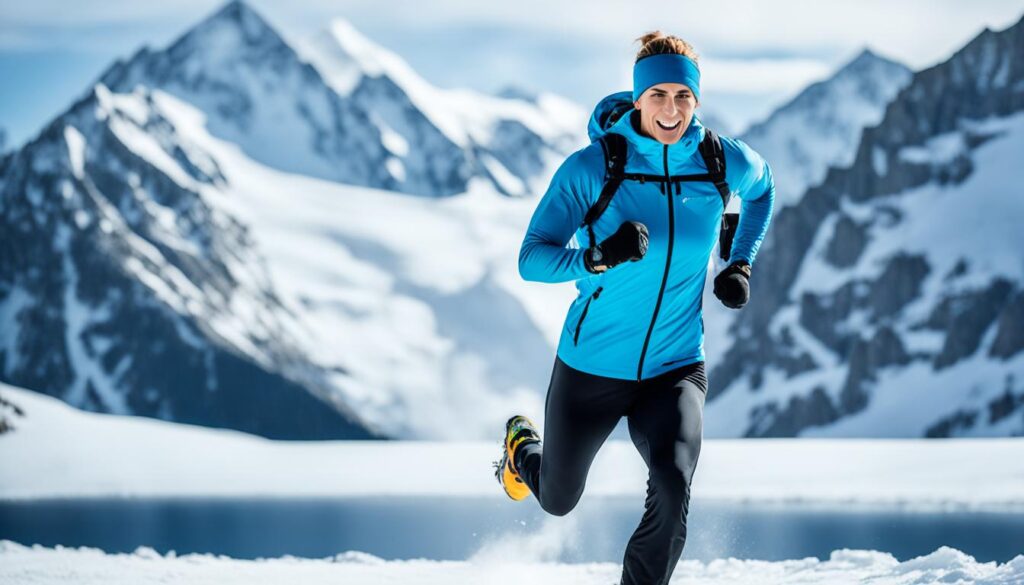
Daily Training Schedule Example:
| Day | Morning | Afternoon |
|---|---|---|
| Monday | Strength training: Squats, lunges, and deadlifts | Cardio: 30-minute run or cycling |
| Tuesday | Rest day | Rest day |
| Wednesday | Cardio: High-intensity interval training | Strength training: Upper body exercises (push-ups, pull-ups, shoulder presses) |
| Thursday | Rest day | Rest day |
| Friday | Cardio: Stairmaster or elliptical workout | Strength training: Core exercises (planks, Russian twists, and stability ball exercises) |
| Saturday | Rest day | Backcountry skiing practice or active recovery |
| Sunday | Cardio: Long-distance run or hike | Rest day |
Note: This is just an example schedule. Adapt based on your fitness and goals.
Additional Tips for Backcountry Skiing Fitness
Getting ready for backcountry skiing needs more than just exercise. Here’s how you can boost your fitness:
- Pay attention to your diet: To perform well, keep a healthy body weight. Eat lots of fruits, veggies, lean proteins, and whole grains. These foods give you the energy for long days of skiing.
- Stay hydrated: Drinking enough water keeps you going strong and stops tiredness. Always have a water bottle with you while skiing. Steer clear of drinks that dehydrate you, like soda or coffee.
- Practice skiing techniques: Being fit is good, but so is knowing how to ski well. Work on making turns, stopping, and speed control on different slopes. This will make you a better skier and keep you fit and quick on the slopes.
- Get familiar with the backcountry: Learn about the specific backcountry you’ll be skiing. Look at maps, check the weather, and talk to experts. Knowing the area helps you get ready for what might come, mentally and physically.
Adding these tips to your fitness plan can make you even more ready and able for skiing.
| Tips | Benefits |
|---|---|
| Pay attention to your diet | Optimal performance on the slopes |
| Stay hydrated | Maintain endurance and prevent fatigue |
| Practice skiing techniques | Improve skills, enhance overall fitness and agility |
| Get familiar with the backcountry | Prepare mentally and physically for challenges |
Why Proper Diet and Hydration are Essential
A healthy diet and staying hydrated are crucial for backcountry skiing fitness. Eating well keeps you fueled up, and water keeps your energy steady and prevents tiredness. Focusing on diet and water means you’re making the most of your skiing, staying strong and free from fatigue.
Conclusion
Backcountry skiing is thrilling and tough, needing both fitness and skill. To ensure an amazing mountain experience and make skiing easier, get fit. A good fitness plan improves how you ski.
Being fit for backcountry skiing means you can go the distance and have the power for tough trails. Run, bike, or use a Stairmaster to boost your heart health. Work on your legs with lunges, squats, and deadlifts. Strengthening your core and improving balance means better control on uneven ground.
Start training early for the ski season. Up the workout intensity as you get closer to skiing. Keep your weight in check, drink plenty of water, and eat well. A healthy body makes backcountry slopes easier to tackle.
FAQ
Why is cardiovascular fitness important for backcountry skiing?
Cardiovascular fitness is key for backcountry skiing. It gives you the energy to climb uphill and keeps you going. This type of fitness is vital for any backcountry skiing program.
What exercises can I do to improve my cardiovascular fitness?
Run, bike, or use a Stairmaster to boost your heart rate. Doing these activities an hour each day helps. They are great for your backcountry skiing plan.
Why is building strength important for backcountry skiing?
Strength is crucial for backcountry skiing. It helps you stay in control and reduces injury risks. Plus, it boosts how well you perform.
What exercises should I focus on to build strength for backcountry skiing?
Focusing on skiing-related muscles is key. Do exercises like lunges, squats, and deadlifts. Including these in your plan is a good idea.
Why is core stability and balance important for backcountry skiing?
Core stability and balance are vital. They help keep your body in the right position on tough slopes. A strong core is needed for stability. Don’t forget to do core and balance exercises for better performance.
What are some examples of core and balance exercises for backcountry skiing?
Try planks, Russian twists, and single-leg squats. They target your core muscles well. Balance exercises on one leg or with a balance board can also help.
How should I structure my backcountry skiing fitness program?
Start training 6 to 8 weeks before the ski season. Have two to three workout days a week. Focus on strength and cardio, and add rest days for recovery. Make your workouts tougher and longer over time.
Are there any additional tips for backcountry skiing fitness?
Watch your diet and stay at a healthy weight. Drink plenty of water and eat right. Working on your skiing skills and spending time on the slopes can also boost your fitness.

